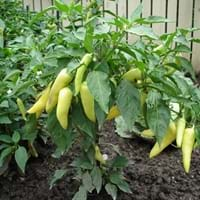Life Span
Perennial
Annual
Type
Bulb or Corm or Tuber
Vegetable
Origin
South America
Mexico, Central America, South America
Types
Pamianthe cardenasii , Pamianthe parviflora , Pamianthe peruviana
Sweet Banana Pepper, Banana Bill Hybrid Pepper, Hot Banana Pepper, Inferno Hot Banana Hybrid Pepper
Number of Varieties
Not Available
Habitat
All sorts of environments
Warmer regions
USDA Hardiness Zone
8-10
9-11
Sunset Zone
21,22
A1, A2, A3, H1, H2, 1a, 1b, 2a, 2b, 3a, 3b, 4, 5, 6, 7, 8, 9, 10, 11, 12, 13, 14, 15, 16, 17, 18, 19, 20, 21, 22, 23, 24
Habit
Clump-Forming
Upright/Erect
Flower Color
White
White, Ivory
Flower Color Modifier
Bicolor
Bicolor
Fruit Color
Green
Light Yellow, Lemon yellow, Yellow green
Leaf Color in Spring
Dark Green
Green, Light Green
Leaf Color in Summer
Light Green
Dark Green
Leaf Color in Fall
Several shades of Green
Dark Green, Black
Leaf Color in Winter
Light Green
Green
Leaf Shape
Strap shaped
Ovate
Plant Season
Spring, Summer, Fall
Spring, Summer, Fall
Sunlight
Partial Sun, Partial shade
Full Sun
Type of Soil
Loam, Sand
Loam
The pH of Soil
Acidic, Neutral, Alkaline
Acidic, Neutral
Soil Drainage
Average
Well drained
Bloom Time
Spring, Late Spring, Early Summer, Summer, Late Summer
Spring, Summer, Fall, Indeterminate
Tolerances
Drought
Drought
Where to Plant?
Ground, Pot
Container, Ground, Pot
How to Plant?
Offsets
Seedlings, Stem Planting
Plant Maintenance
Medium
Medium
Watering Requirements
Keep the ground moist but not water-logged
Over-head watering
In Summer
Lots of watering
Lots of watering
In Spring
Moderate
Moderate
In Winter
Average Water
Average Water
Soil pH
Acidic, Neutral, Alkaline
Acidic, Neutral
Soil Type
Loam, Sand
Loam
Soil Drainage Capacity
Average
Well drained
Sun Exposure
Partial Sun, Partial shade
Full Sun
Pruning
Pinch or prune as they grow to promote branching and bushiness, Remove damaged leaves, Remove dead branches, Remove dead leaves, Requires little pruning
Prune after harvesting, Prune in late winter, Prune lower leaves
Fertilizers
All-Purpose Liquid Fertilizer, High phosphorus
All-Purpose Liquid Fertilizer
Pests and Diseases
Leaf spot, Mosaic viruses
Red blotch
Plant Tolerance
Drought
Drought
Flowers
Showy
Insignificant
Flower Petal Number
Single
Single
Foliage Texture
Coarse
Medium
Foliage Sheen
Glossy
Glossy
Attracts
Bees, Birds, Bumblebees, Butterflies, Hummingbirds, pollinators
Bees
Allergy
Unknown
breathing problems, inflammation in lips, Runny nose, sneezing
Aesthetic Uses
Beautification, Bouquets, Ornamental use, Showy Purposes
Not Used For Aesthetic Purpose
Beauty Benefits
No Beauty Benefits
Not Available
Environmental Uses
Air purification
Air purification
Medicinal Uses
No Medicinal Use
Digestive disorders, Heart problems, High blood pressure, Inflammation
Part of Plant Used
Not Available
Fruits
Other Uses
Beneficial species for attracting pollinators, Decoration Purposes
Not Available
Used As Indoor Plant
No
No
Used As Outdoor Plant
Yes
Yes
Garden Design
Bog Garden, Container, Feature Plant, Foundation, Mixed Border, Water Gardens
Container, Edible, Herb / Vegetable, Tropical
Botanical Name
HYMENOCALLIS longipetala
CAPSICUM annuum 'Park's Sweet Banana Whopper'
Common Name
Peruvian Daffodil, Spiderlily
Banana Pepper, Park's Sweet Banana Whopper Pepper
In Hindi
peruvian daffodil
केले मिर्च
In German
peruvian daffodil
Banana Pfeffer
In French
peruvian daffodil
Banana Pepper
In Spanish
Pamianthe
banano Pimienta
In Greek
peruvian daffodil
Πιπεριά Μπανάνα
In Portuguese
peruvian daffodil
Banana pimenta
In Polish
peruvian daffodil
Banana Pepper
In Latin
peruvian daffodil
Musa sapientum fixa Pepper
Phylum
Magnoliophyta
Not Available
Class
Liliopsida
Not Available
Order
Asparagales
Solanales
Family
Amaryllidaceae
Solanaceae
Clade
Angiosperms, Monocots
Not Applicable
Tribe
Clinantheae
Not Available
Subfamily
Amaryllidoideae
Not Available
Number of Species
Not Available
Not Available
Season and Care of Peruvian Daffodil and Banana Pepper
Season and care of Peruvian Daffodil and Banana Pepper is important to know. While considering everything about Peruvian Daffodil and Banana Pepper Care, growing season is an essential factor. Peruvian Daffodil season is Spring, Summer and Fall and Banana Pepper season is Spring, Summer and Fall. The type of soil for Peruvian Daffodil is Loam, Sand and for Banana Pepper is Loam while the PH of soil for Peruvian Daffodil is Acidic, Neutral, Alkaline and for Banana Pepper is Acidic, Neutral.
Peruvian Daffodil and Banana Pepper Physical Information
Peruvian Daffodil and Banana Pepper physical information is very important for comparison. Peruvian Daffodil height is 61.00 cm and width 61.00 cm whereas Banana Pepper height is 55.90 cm and width 45.70 cm. The color specification of Peruvian Daffodil and Banana Pepper are as follows:
Peruvian Daffodil flower color: White
Peruvian Daffodil leaf color: Dark Green
Banana Pepper flower color: White and Ivory
- Banana Pepper leaf color: Green, Light Green
Care of Peruvian Daffodil and Banana Pepper
Care of Peruvian Daffodil and Banana Pepper include pruning, fertilizers, watering etc. Peruvian Daffodil pruning is done Pinch or prune as they grow to promote branching and bushiness, Remove damaged leaves, Remove dead branches, Remove dead leaves and Requires little pruning and Banana Pepper pruning is done Prune after harvesting, Prune in late winter and Prune lower leaves. In summer Peruvian Daffodil needs Lots of watering and in winter, it needs Average Water. Whereas, in summer Banana Pepper needs Lots of watering and in winter, it needs Average Water.





